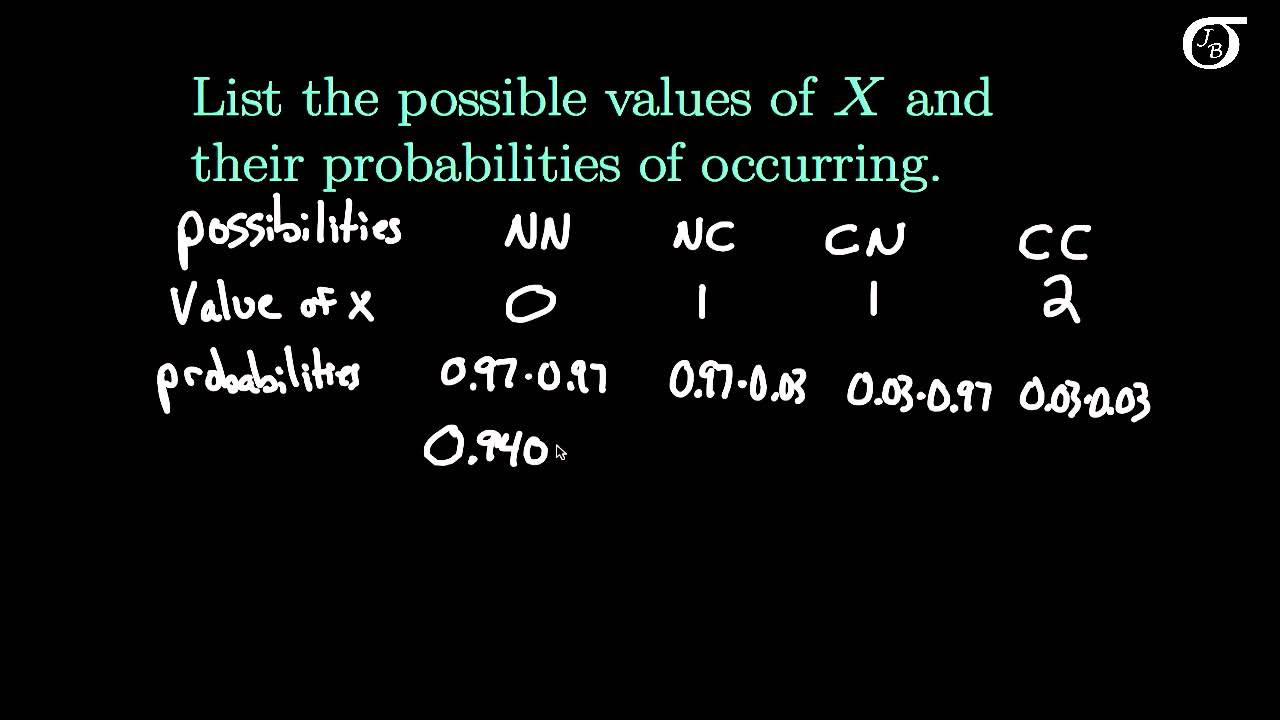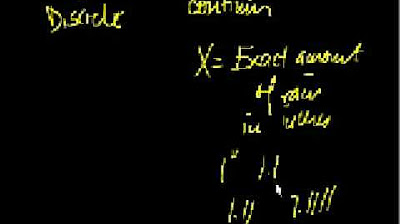Probability Theory 10 | Random Variables
TLDRIn this probability theory video, the concept of random variables is introduced as a straightforward way to encapsulate the relevant information of a random experiment into a single object, typically denoted by a capital letter like X. The video uses the example of rolling two dice to illustrate how a random variable can represent the sum of the dice, focusing on the outcome rather than the individual dice. It explains the formal definition of a random variable as a measurable map between two measurable spaces, emphasizing the importance of the pre-images of events belonging to the sigma algebra. The video concludes with the notation P(X ∈ A), which represents the probability of the event that the random variable X falls within a certain set A, providing a foundation for further exploration in probability theory.
Takeaways
- 📚 The video discusses the concept of random variables in probability theory.
- 🎲 Random variables are introduced as a way to encapsulate the relevant information from a random experiment into one object, often denoted by a capital letter like X.
- 🔢 The video uses the example of rolling two dice to illustrate how a random variable can represent the sum of the numbers rolled, regardless of the dice's colors.
- 🎯 The sample space (Ω) for rolling two dice is the Cartesian product of the numbers 1 to 6 with itself, and the sigma algebra (A) is the power set, representing all possible outcomes.
- 🎨 The probability measure (P) is given by the uniform distribution, meaning each outcome is equally likely.
- 🌐 A random variable is defined as a measurable map from one sample space (Ω) to another (Ω') with corresponding sigma algebras (A and A').
- 📉 The codomain of a random variable is often the set of real numbers, but it can be generalized to other sets of values.
- 📌 The definition of a random variable requires that the pre-images of events in the second sample space are elements of the first sample space's sigma algebra.
- 🚫 The video provides an example where changing the sigma algebra to the smallest one (only containing the empty set and the whole set) results in a non-random variable.
- 📝 The notation P(X ∈ A') is introduced to denote the probability of the pre-image of a set A' under the random variable X, which is a shorthand for a more complex set notation.
- 🔑 The takeaway emphasizes that random variables are a fundamental concept in probability theory and are not complicated once understood.
Q & A
What is the main topic discussed in the video script?
-The main topic discussed in the video script is the concept of random variables in probability theory.
Why are random variables considered simple and natural in the context of the script?
-Random variables are considered simple and natural because they encapsulate all the relevant information of a random experiment into one object, making it easier to work with the outcomes of the experiment.
What is the usual notation used for random variables in the script?
-The usual notation used for random variables in the script is a capital letter, such as capital X.
Can you explain the example given in the script involving throwing two dice?
-The example involves throwing two dice, one red and one green, which is equivalent to throwing one die twice. The sample space Omega is the Cartesian product of the numbers 1 to 6 with itself, and the probability is given by a uniform distribution.
What is the purpose of defining a random variable in the dice-throwing example?
-The purpose of defining a random variable in the dice-throwing example is to focus on the sum of the numbers shown on the dice, which might be relevant for a game, while disregarding the colors of the dice which are not important.
What is a measurable space or event space as mentioned in the script?
-A measurable space or event space is a set with a corresponding sigma algebra, which is used to define the events and their probabilities in probability theory.
What is the condition for a map to be considered a random variable?
-A map is considered a random variable if it is a measurable map, meaning that for every event in the second sample space, its pre-image under the map is an element of the sigma algebra of the first sample space.
Why does the choice of sigma algebra affect whether a map is a random variable?
-The choice of sigma algebra affects whether a map is a random variable because the pre-image of every event in the second sample space must be an element of the sigma algebra of the first sample space for the map to be measurable.
What is the Borel sigma algebra, and why is it commonly used with the real number line?
-The Borel sigma algebra is the sigma algebra generated by all open intervals in the real number line. It is commonly used with the real number line because it is the smallest sigma algebra that includes all open sets and is sufficient for most probability measures.
What is the notation used for the probability of an event given the pre-image of a random variable?
-The notation used for the probability of an event given the pre-image of a random variable is P(X in A tilde), where X is the random variable and A tilde is an event in the second sample space.
Why might the notation P(X in A tilde) seem odd at first glance?
-The notation P(X in A tilde) might seem odd at first because it appears to suggest that a single value of X is being considered, whereas it actually represents the probability of the set of all outcomes in Omega where X maps to an event in A tilde.
Outlines
🎲 Introduction to Random Variables
This paragraph introduces the concept of random variables in the context of probability theory. It begins by expressing gratitude to supporters and then moves on to explain that random variables are simple and natural constructs used to encapsulate all relevant information from a random experiment into a single object, typically denoted by a capital letter like 'X'. The explanation includes a basic example of rolling two dice, which is analogous to rolling one die twice, and how this can be represented in terms of a probability space with a sample space, sigma algebra, and a uniform probability distribution. The paragraph emphasizes that random variables are used to extract specific information of interest from the outcomes of an experiment, such as the sum of the dice rolls, rather than the colors of the dice. It concludes with the promise of a formal definition and further discussion on the properties of random variables.
📊 Measurable Spaces and Random Variables
The second paragraph delves into the formal definition of random variables within the framework of measurable spaces or event spaces. It explains that a random variable is a measurable map from one sample space, denoted by Omega with sigma algebra A, to another space, denoted by Omega tilde with sigma algebra A tilde. The paragraph clarifies that for a map to be considered a random variable, it must satisfy the condition that the pre-image of any event in the second space (an element of A tilde) must be an element of the sigma algebra A. The discussion includes examples to illustrate the conditions under which a map is a random variable, contrasting the cases where the sigma algebra is the power set (all subsets are measurable) and when it is the trivial sigma algebra (only the empty set and the whole set are measurable). The paragraph concludes with a note on notation, explaining the shorthand 'P(X in A tilde)' as a way to express the probability of the pre-image of a set under a random variable X, and hints at further exploration of this notation in subsequent videos.
Mindmap
Keywords
💡Random Variables
💡Sample Space (Omega)
💡Sigma Algebra (A)
💡Measurable Spaces
💡Measurable Map
💡Borel Sigma Algebra
💡Uniform Distribution
💡Pre-image
💡Probability Measure
💡Notation P(X in A tilde)
Highlights
Introduction to the concept of random variables in probability theory.
Random variables simplify the representation of information from random experiments.
Capital letters, such as X, are commonly used to denote random variables.
Random variables are maps from a sample space to a set of values, often the real numbers.
Generalization of random variables to different sets of values is discussed.
An example of rolling two dice to illustrate the concept of a random variable.
Explanation of the sample space and sigma algebra in the context of dice rolling.
The probability measure is given by the uniform distribution in the dice example.
Random variables allow focusing on specific outcomes, like the sum of dice rolls, rather than all details.
The formal definition of a random variable as a measurable map between measurable spaces.
The importance of the pre-image of events in defining a random variable.
The trivial fulfillment of the random variable condition when the sigma algebra is the power set.
Contrasting examples with different sigma algebras to illustrate the definition of a random variable.
The use of the Borel sigma algebra for the real number line in the context of random variables.
The notation P(X in A tilde) for expressing the probability of an event related to a random variable.
The practical interpretation of the notation P(X in A tilde) in terms of pre-images.
The video concludes with a summary of the simplicity and commonality of random variables in probability theory.
Transcripts
Browse More Related Video
5.0 / 5 (0 votes)
Thanks for rating:





